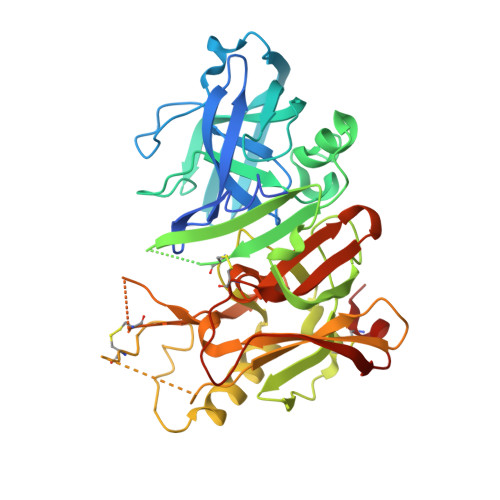From Fragment Screening to In Vivo Efficacy: Optimization of a Series of 2-Aminoquinolines as Potent Inhibitors of Beta-Site Amyloid Precursor Protein Cleaving Enzyme 1 (BACE1).
Cheng, Y., Judd, T.C., Bartberger, M.D., Brown, J., Chen, K., Fremeau, R.T., Hickman, D., Hitchcock, S.A., Jordan, B., Li, V., Lopez, P., Louie, S.W., Luo, Y., Michelsen, K., Nixey, T., Powers, T.S., Rattan, C., Sickmier, E.A., St Jean, D.J., Wahl, R.C., Wen, P.H., Wood, S.(2011) J Med Chem 54: 5836-5857
- PubMed: 21707077
- DOI: https://doi.org/10.1021/jm200544q
- Primary Citation of Related Structures:
3RSV, 3RSX, 3RTH, 3RTM, 3RTN, 3RU1, 3RVI - PubMed Abstract:
Using fragment-based screening of a focused fragment library, 2-aminoquinoline 1 was identified as an initial hit for BACE1. Further SAR development was supported by X-ray structures of BACE1 cocrystallized with various ligands and molecular modeling studies to expedite the discovery of potent compounds. These strategies enabled us to integrate the C-3 side chain on 2-aminoquinoline 1 extending deep into the P2' binding pocket of BACE1 and enhancing the ligand's potency. We were able to improve the BACE1 potency to subnanomolar range, over 10(6)-fold more potent than the initial hit (900 μM). Further elaboration of the physical properties of the lead compounds to those more consistent with good blood-brain barrier permeability led to inhibitors with greatly improved cellular activity and permeability. Compound 59 showed an IC(50) value of 11 nM on BACE1 and cellular activity of 80 nM. This compound was advanced into rat pharmacokinetic and pharmacodynamic studies and demonstrated significant reduction of Aβ levels in cerebrospinal fluid (CSF).
- Chemistry Research and Discovery, Amgen Inc., One Amgen Center Drive, Thousand Oaks, California 91320, USA. yuanc@amgen.com
Organizational Affiliation:



















